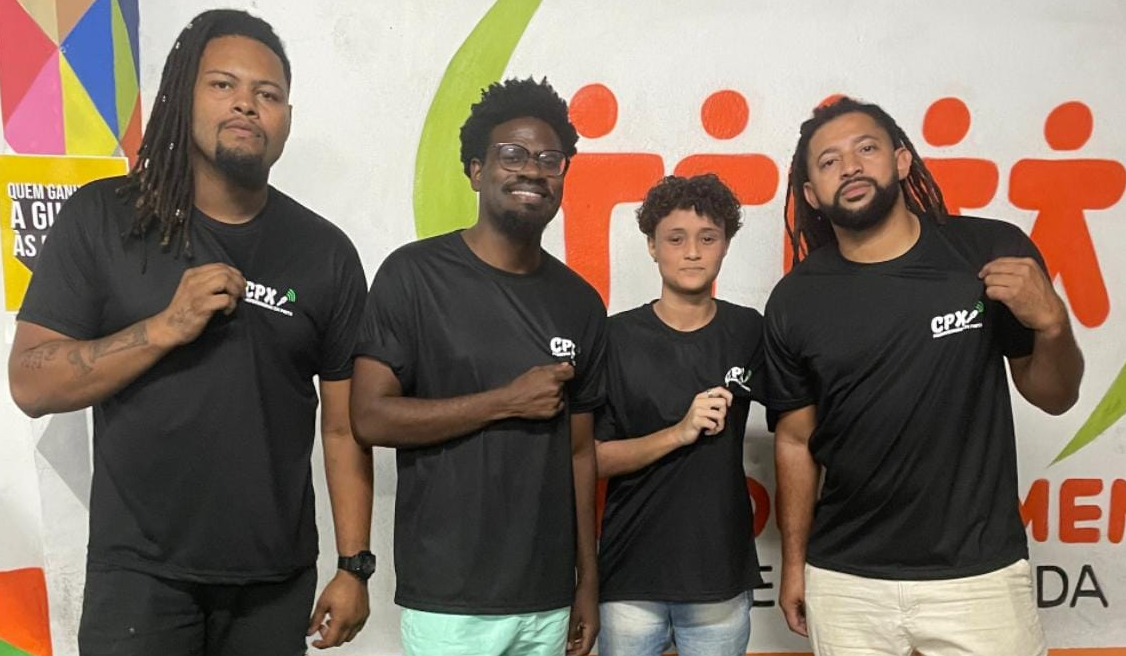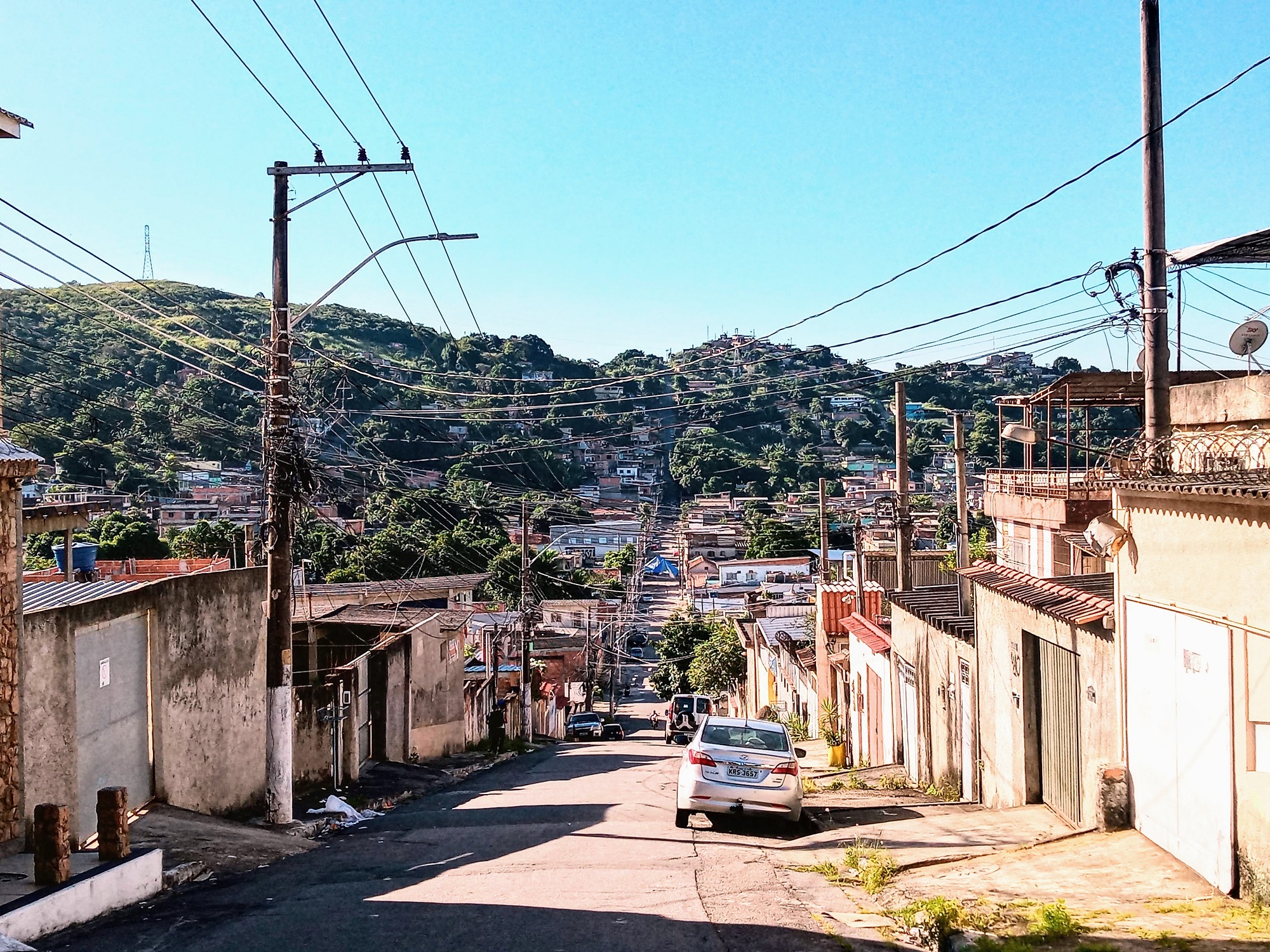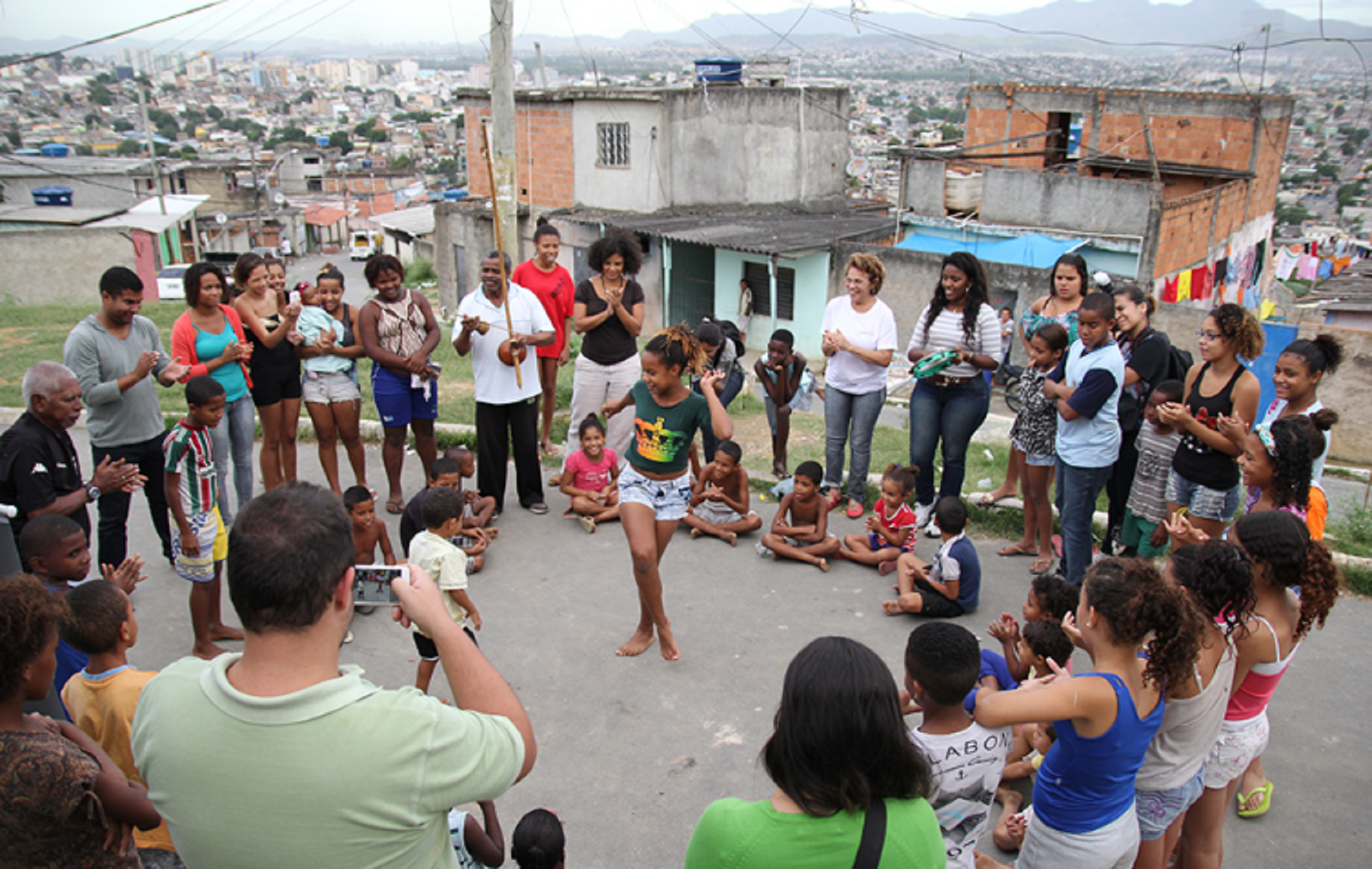
Check out our complete series of community media profiles here.
Complexo da Mangueirinha, in Duque de Caxias, is the largest cluster of favelas in Greater Rio de Janeiro’s Baixada Fluminense region. There, where the presence of the State is primarily felt through its security forces, a group of young people tired of the biased, prejudiced, and often unreal narratives from mainstream media about their territories rolled up their sleeves and, in April 2023, founded the newest communication channel for the favelas of the Baixada Fluminense: CPX Mangueirinha em Pauta.
One of the project’s creators, Pedro Vinícius Lobo, 31, is a student of public relations involved with other media collectives such as Portal Favelas. Another, Adilenon Jorge, better known as Lennon Kira, 26, is a social sciences student and rapper in his spare time. Both are students at the State University of Rio de Janeiro (UERJ). They joined forces with residents Wallace Clayton and Jade Albuquerque, who, besides being reporters, also hold administrative roles in the collective. Lobo states that the social and political landscapes of the region were the guiding elements for the formation of the collective. He was surprised, for instance, by the number of voters from his community who elected Cláudio Castro governor of the state of Rio, a politician known for showcasing power through bloody police operations in favelas and peripheral areas, and who remains silent in the face of violations and abuses committed by public security agents under his responsibility.
“Residents’ perceptions of reality are solely based on how the media portrays us: in a derogatory manner. Our concern is to identify what residents want as a demand, how they genuinely want to be seen. This ends up reflecting in various aspects, including voting. The vast majority here voted for a governor whose priority is the extermination of these very residents. It’s as if the ant were voting for the pest control company.” — Pedro Vinícius Lobo

Contemplating the favelas of Mangueirinha, Santuário, Corte 8, Lagoinha, Morro do Sapo, Favelinha de Caxias (Escadão, Curva da Morte, Rua Aureliano Lessa, Rua J.J. Seabra, and Caixa d’Água), as well as Morro do São Pedro, Complexo da Mangueirinha gained notoriety when the mainstream media reported on the installation of the first and only Pacifying Police Unit (UPP) in the Baixada Fluminense, which operated between 2014 and 2018. This installation occurred at a time when the State’s pacification policy was already on its deathbed, falling apart. Destabilized, the Mangueirinha UPP was dissolved, becoming a detachment of the Military Police in 2018
“No one asked us, at the time, if we wanted it [this UPP] here. They didn’t ask us if we wanted a daycare center, a healthcare facility, if we needed to get around more easily or if we’d like guarantees that what we already had, in terms of public facilities, would continue to work.” — Pedro Vinícius Lobo
Regarding the concerns of residents about their territories, Lennon explains that they inevitably revolve around security. According to him, there are two types of security that worry those in the favelas: physical security, to avoid becoming fatal victims of shootings or police violence; and food security, as there are many cases of entire families experiencing hunger in the favelas.
“The focus of attention always ends up predominantly at the entrance of the favela, but many forget that up there, on the very top of the hill, many are living precariously, in wooden houses. It’s very easy to portray Rio de Janeiro as the home of soccer, carnival, Christ the Redeemer, and the Lapa arches. Journalists living in the [city’s affluent] South Zone don’t show the needs of Baixada residents. We go the extra mile to access spaces that are treated as if they don’t exist.” — Lennon Kira
One of the challenges of CPX Mangueirinha em Pauta is covering the long distances of the favela complex, almost always on foot. Many alleys and lanes are very narrow, and walking is necessary to ensure that no area is left uncovered. Sometimes, imminent shootings force a detour so reporters don’t become targets.
“Since we’re local, I always ask that we get out of our comfort zone. Let’s walk, for real, so that we can feel like we’re a part of the greater complex, you know? [Normally], I don’t walk around all the favelas, even if they are controlled by the same [criminal] faction. I’m not sure what the youngest ones in the movement, who are usually more hyped up, will think about this. They’ll probably find it strange that I cover so much ground around here. I know the older crowd will respect that.” — Pedro Vinícius Lobo

The First Days of CPX Mangueirinha em Pauta
The first few days were pure hustle. Getting together for editorial meetings, splitting up assignments, and producing stories yielded an intense routine according to Lennon. The first 30 days were crucial to perform an evaluation of the limitations and possibilities of the collective’s continuity.
“We worked every day, Sunday to Sunday. Even on Mother’s Day we abdicated from being with our families in order to cover events taking pictures, doing interviews, listening to what people had to say about the event. Yesterday, for instance, we met until midnight. Besides, everyone has their own work, their own hustle.” — Lennon Kira

In this first phase, the stories highlighted local residents, such as DJ DRika and MC Rafinha, producers and creators of the Centenário Cultural Circle, which is part of Duque de Caxias’s hip-hop scene. Both are residents of Lagoinha, in Complexo da Mangueirinha, an area frequently remembered for a massacre perpetrated by the Rio de Janeiro Military Police in 2008, when ten people were murdered. Among other subjects, the interview with the couple deals with pregnancy, support networks, and what it’s like to produce peripheral culture carrying “a whole universe in your belly.”
There’s also an exchange with motorcycle courier and soccer referee Emerson de Souza Rocha, a member of the Rio de Janeiro Soccer Federation (Ferj) and organizer of various regional championships.
The news is produced collectively by whoever is available when events take place. The entire team carries out multiple tasks—everyone needs to know how to write, take pictures, edit videos, manage and take care of the visual identity of CPX Mangueirinha em Pauta on social media. The collective will soon launch a website, which hasn’t gone live while they study the platform’s digital security. Social media and messaging apps, such as WhatsApp, help map out what has been going on in the favelas of Manguerinha. They get messages from residents sharing information on the most varied themes, such as shootouts resulting from a police operation or community events scheduled for the weekend.
“Everyone here is in a bunch of WhatsApp groups. It’s also a way for us to protect ourselves since many of us are family men. We need to be connected with everything that’s going on. Right now, it’s important that we’re present in these places because some members of these groups live in areas considered inaccessible. If we leave here and go to Lagoinha, for instance, we’ll have to take a huge detour and go all the way to downtown Caxias. We might get there and find there’s a conflict going on that we don’t know about. [And that’s a problem, since] staying informed is yet another way of navigating risks.” — Pedro Vinícius Lobo
Dilemmas and Cruel Perceptions
The members of the collective also provided other tips on how to survive journalistically in favelas. For them, the main condition that ensures the collective’s work continues to unfold with quality and effectiveness is a good relationship with sources. Having close ties with the leaders of residents’ associations is helpful, for instance.

One of the most sensitive points in the conversation with the collective’s members was regarding the daily human rights violations endured by those living in the favelas. Being a content producer from the favelas, unable to escape the perverse stereotype of being a potential target of State-sanctioned atrocities, reveals a personal drama experienced by Lennon. At the age of 12, on his way to school one morning, he was struck by two shots from a 556 rifle. He reveals that there was a third shot, fired by a State agent with the intention of intimidating him. One bullet grazed his right leg, while the second entered his left leg and remains there to this day. “It lodged in the femoral vein. If the bullet is removed, I could bleed to death,” says Lennon.
Even while trying to recover physically and mentally, channeling in a positive way what could have resulted in his death, the communicator became a victim of a second violent episode perpetrated by State police forces. In a police operation, his home was invaded without a judicial warrant. During the invasion, Lennon was thrown to the ground by a Military Police officer, who stepped on his chest with a boot, shouting that he would kill him. He was labeled a drug dealer by the police, due to his long dreadlocks, his trademark as a cultural activist in the hip-hop movement. But not even this squashed his perseverance in spreading democracy and freedom of expression across the communities of Mangueirinha.
“Building this collective helps alleviate, to a certain extent, the trauma I acquired from these episodes. Because when that happened to me, I had no one to turn to. Now residents will always have someone to lean on when their rights are violated. We can forward their complaints to the Public Prosecutor. We want to try, as much as possible, to break away from this policy of fear that the State instills in us. Those of us who live in a favela are afraid of the rival faction, the police, the thief, the militia. We live as if we’re under siege.” — Lennon Kira
About the author: Fabio Leon is a journalist, human rights activist, and media advisor with Fórum Grita Baixada.
